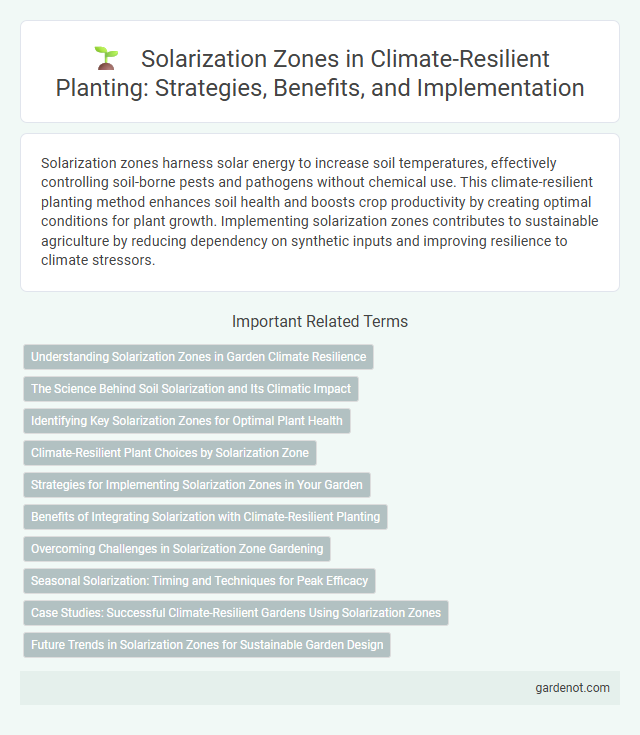Solarization zones harness solar energy to increase soil temperatures, effectively controlling soil-borne pests and pathogens without chemical use. This climate-resilient planting method enhances soil health and boosts crop productivity by creating optimal conditions for plant growth. Implementing solarization zones contributes to sustainable agriculture by reducing dependency on synthetic inputs and improving resilience to climate stressors.
Understanding Solarization Zones in Garden Climate Resilience
Solarization zones refer to garden areas where solar heat is harnessed to improve soil health and suppress pests, enhancing climate resilience. These zones utilize clear plastic covers to trap solar energy, raising soil temperatures to levels that eliminate harmful pathogens and weed seeds. Understanding the specific microclimate within each solarization zone enables gardeners to optimize planting schedules and select heat-tolerant crops, increasing overall garden productivity in changing climates.
The Science Behind Soil Solarization and Its Climatic Impact
Soil solarization uses solar energy to heat the soil to temperatures that eliminate soil-borne pests, pathogens, and weeds, enhancing plant health and yield. This technique involves covering moist soil with transparent polyethylene sheets during peak sunlight months, creating a greenhouse effect that raises soil temperature to 45-60degC. By reducing the need for chemical pesticides and improving soil structure, solarization contributes to climate-resilient agriculture and decreases greenhouse gas emissions.
Identifying Key Solarization Zones for Optimal Plant Health
Identifying key solarization zones involves mapping areas with high solar radiation exposure to enhance soil temperature and effectively reduce soil-borne pathogens. This technique optimizes plant health by promoting stronger root development and improving nutrient availability. Targeting regions with consistent intense sunlight ensures maximum efficacy of solarization in climate-resilient planting strategies.
Climate-Resilient Plant Choices by Solarization Zone
Solarization zones determine the effectiveness of soil solarization in eliminating pathogens and enhancing soil health, guiding climate-resilient plant choices suited to local temperature patterns. Plants with heat tolerance and drought resistance, such as agave or certain native grasses, thrive in high solarization zones where intensified soil warming occurs. Selecting species adapted to the microclimates created by solarization zones ensures sustainable growth and improved crop resilience against climate stressors.
Strategies for Implementing Solarization Zones in Your Garden
Establish solarization zones by selecting garden areas with maximum sun exposure and covering the soil with transparent polyethylene sheets to trap solar heat effectively. Maintain soil moisture before covering to enhance heat conduction and leave the plastic in place for 4 to 6 weeks during peak sunlight for optimal pathogen and weed seed eradication. Integrate crop rotation post-solarization to improve soil health and sustain climate-resilient plant growth.
Benefits of Integrating Solarization with Climate-Resilient Planting
Integrating solarization with climate-resilient planting enhances soil health by increasing temperature to suppress soil-borne pests, pathogens, and weed seeds, leading to higher crop yields and reduced dependency on chemical inputs. This method improves soil nutrient availability and moisture retention, supporting plant growth under variable climatic conditions. Solarization also accelerates organic matter decomposition, fostering a fertile and resilient planting environment that withstands extreme weather events.
Overcoming Challenges in Solarization Zone Gardening
Solarization zones present unique challenges including high soil temperatures and variable moisture levels that impact crop viability and growth. Implementing heat-tolerant plant varieties and optimizing irrigation schedules can mitigate stress on plants, enhancing survival rates during peak solarization periods. Integrating organic mulch and shade structures further reduces soil temperature fluctuations, promoting healthier root development and improved yields.
Seasonal Solarization: Timing and Techniques for Peak Efficacy
Seasonal solarization maximizes soil disinfestation by leveraging peak sunlight during the hottest months, typically late spring through summer. Techniques include covering moist soil with transparent polyethylene sheets for 4 to 6 weeks, trapping solar energy to elevate soil temperatures above 45degC (113degF), effectively neutralizing pathogens, weeds, and pests. Optimal timing aligns with local climate patterns to ensure sustained high soil temperatures, enhancing plant resilience and improving crop yields in climate-resilient planting systems.
Case Studies: Successful Climate-Resilient Gardens Using Solarization Zones
Case studies of climate-resilient gardens using solarization zones demonstrate significant improvements in soil health and pest control through solar thermal treatments. In regions with strong sunlight exposure, these zones raised soil temperatures to levels that effectively eliminated pathogens and weed seeds, resulting in higher crop yields and reduced reliance on chemical pesticides. Success stories from California and Mediterranean climates highlight the adaptability of solarization techniques in enhancing garden resilience to climate stresses.
Future Trends in Solarization Zones for Sustainable Garden Design
Future trends in solarization zones emphasize integrating advanced materials that enhance soil warming and pest control while reducing energy consumption. Innovations in smart sensors and IoT technology enable real-time monitoring of temperature and moisture levels, optimizing plant growth conditions. Expanding solarization applications in urban agriculture promotes sustainable garden design by improving soil health and resilience against climate change impacts.
Solarization zone Infographic

 gardenot.com
gardenot.com